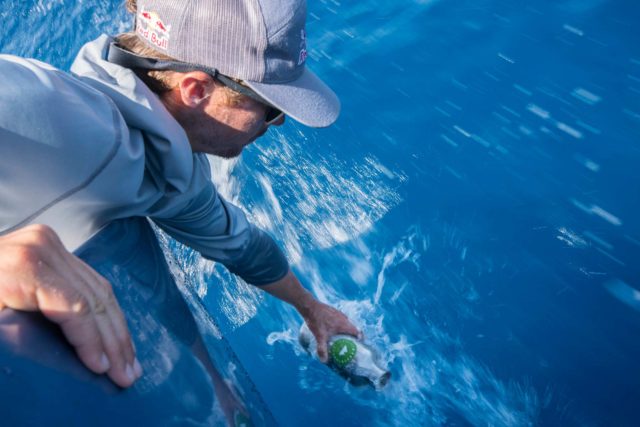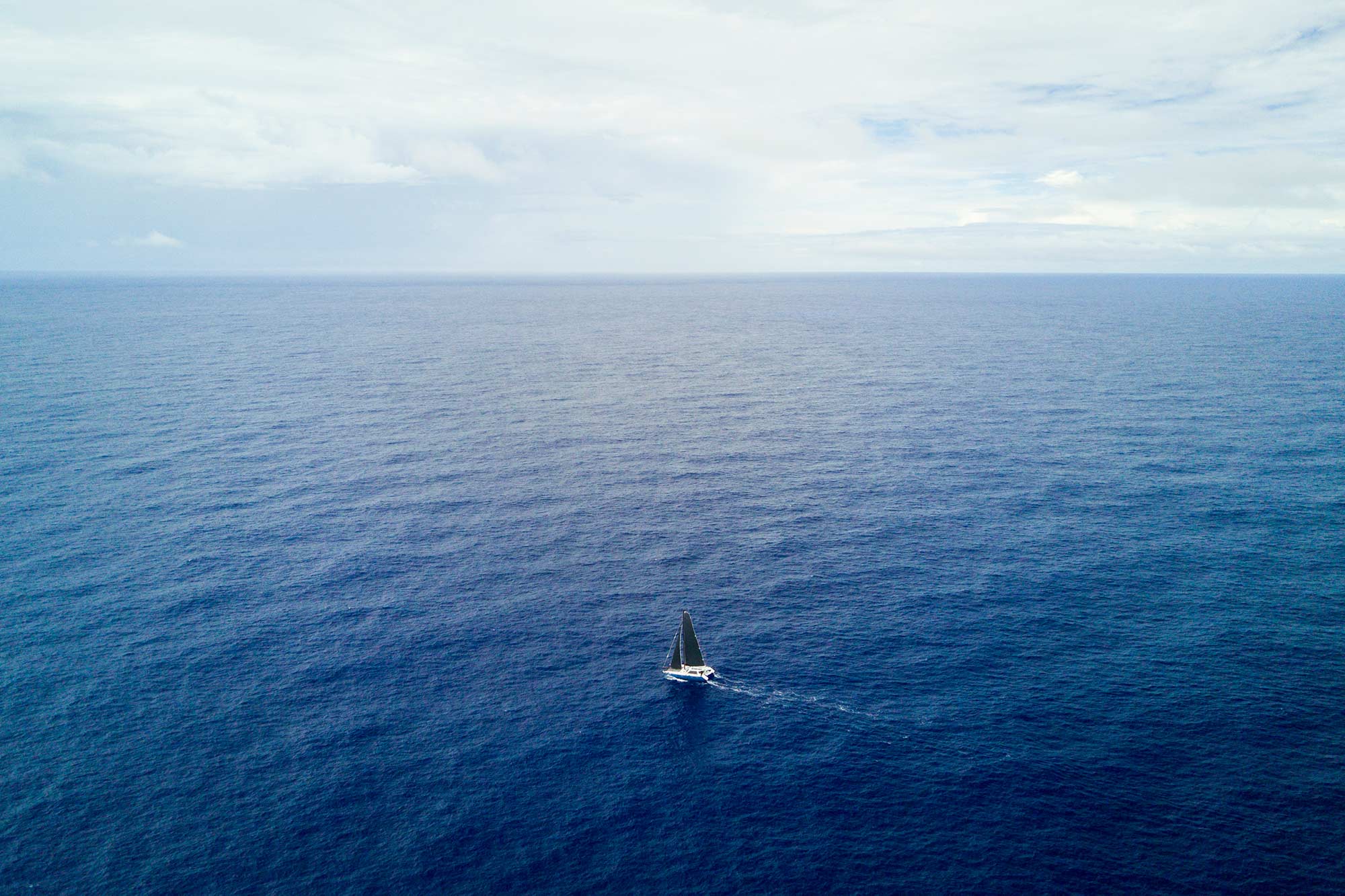
Travis Rice is a professional snowboarder, but on Sept. 19, he leaned over the side of his GunBoat 48 catamaran and dipped a one-liter stainless steel bottle, stamped with the Adventure Scientists logo, into the middle of the Pacific Ocean.
He let the salty water stream in before pulling it back on deck. It was the 13th water sample he and his partner, big-wave pro-surfing legend Ian Walsh, had collected their 19-day, 2,500-nautical-mile sailing and surfing expedition. They were in the second week of their journey, which traced an old Polynesian route along the Line Islands from Tahiti to Hawaii. The 22 ocean samples they’d collect (one every 100 miles or so) would later be shipped to a lab in Maine, where Adventure Scientists partner Abby Barros would conduct a laboratory analysis of microplastic pollution.
“It was a special expedition,” says Katie Christiansen, the Adventure Scientists’ Global Microplastics Initiative project manager. “They were going to be traveling this [area] that we had not had samples collected from before.”
The two pro-athletes had always wanted to explore the remote waters between Tahiti and Hawaii — the kind that swell crisp turquoise in beachy surf dreams. So when the Boulder-based ROAM media company asked Rice and Walsh if they wanted to document the expedition, and if they’d be willing to partner with Adventure Scientists to collect data along the way, it was a “natural marriage,” says Chris Jerard, ROAM’s founder and CEO.
Both Christiansen and Jerard recognized the power in pairing the visual impact and social reach of ROAM’s imagery with the scientific weight of Adventure Scientists’ data. The partnership fell right into step with Aristotle’s proclamation: “The whole is greater than the sum of its parts.”

Falcor is built for this and over the six years I have owned her she has really transformed into a spaceship in the sense that she is completely off grid and capable of multi-month trips without the need for water, power or provisions… She takes a huge amount of work but over the years my lady and I have learned the ins and outs of her and through pure necessity I have become a mechanic, electrician, plumber, medic, gourmet boat chef and tour host to name a few… Thank you Falcor for always challenging me to learn. #fakeittillyoumakeit #universitydegreeinproblemsolving — Travis Rice ROAM/Avery Ross
ROAM reaches over 1 million people through social media, while Adventure Scientists conducts world-class research about environmental challenges. In adding a scientific-purpose to art, and social-networking to science, it was more than a win-win. It was a way to amplify each other’s missions beyond the scope of what they could achieve alone.
By partnering with Adventure Scientists, Jerard says ROAM was able to fulfill a special part of the company’s mission. “At this time in our history, and with everything that’s happening with our planet, we at ROAM feel like we have a responsibility and an obligation to call attention to the fact that if you’re going to play in these spaces, try to think about what else is going on in this environment.”
And without ROAM, Christiansen explains, Adventure Scientists wouldn’t have been able to communicate their findings to as many people, or to such diverse communities. The Bozeman-based nonprofit takes advantage of the unique geographic terrain that adventurers travel by partnering with outdoor athletes, professional or amateur. But informing the public is a crucial part of what they hope to achieve — to draw the data beyond their spreadsheets.

—Travis Rice
The simplicity of using the whatever wind there is. We are starting to feel the first few puffs of North Pacific tradewinds. — Ian Walsh ROAM/Avery Ross
For the past four years, the Global Microplastics Initiative has amassed one of the largest and most diverse water sample datasets in order to expose the extent of microplastic pollution around the globe.
Microplastics, pieces of plastic less than 5 millimeters in diameter, “pose serious threats to ecosystems,” says Christiansen. “They originate most often from the degradation of some larger synthetic or plastic object.” She points to a synthetic fleece sweater as an example. “The problem is that over time those products experience wear,” which you can see, for example, pulling the lint trap from a dryer. “Those [materials] break down and they become these small, most of the time invisible to the eye, pieces of plastic.”
Eventually microplastics snake through sewers, or directly through trash in the rain, down to the ocean. When microplastics arrive in the sea, plankton eat them because they look like algae. A baby fish will eat a thousand plankton (and microplastics) for breakfast, then a bigger fish eats that fish for lunch, and we eat the biggest fish for dinner — the one that’s accumulated the most microplastic in its system.
“Scientists have shown [the consumption of microplastics] can affect fish mortality, their ability to reproduce, their hormones,” Christiansen says. “The effect on humans is unknown, but quite frankly, I’m not interested in consuming something that, in fish, is shown to affect their ability to reproduce or their ability to live a long life.”

That 13th sample that Rice pulled out from the untouched Pacific contained one translucent microfiber. In total, 73 percent of the water they collected contained microplastics — the extent of human impact on even the most pristine corners of the Earth as clear as the ocean appeared itself.
Originally, Rice and Walsh live-streamed their expedition from ROAM’s social media platforms. This immediately began attracting attention, says Jerard. In December, ROAM released a 15-minute documentary, Lines to Hawaii, chronicling the sail-surf-water sample expedition.
Live-streaming updates from the catamaran out to the rest of the world was relatively groundbreaking. “We say ROAM is the voice of the next generation of adventure,” Jerard explains. Until ROAM’s debut merely nine months ago, “there was not a media outlet that moved at the speed of social,” meaning no one else was consistently producing original live adventure content. This matters, considering 80 percent of audiences would rather watch a brand’s live video than read a blog, according to a Live Stream research team. Within a few months, ROAM’s social reach surpassed 1 million. To date, Lines to Hawaii has 1.2 million views.
“You can see in the [social media] comments that [the microplastics initiative] was an important concept for the people that follow them — to know that their idols care about this,” Christiansen says. “They do a great job of both expressing the reality and the severity of the problem we face. But also showing that we don’t have to just sit and be depressed about it; we can participate in solving a problem, so there’s optimism in that as well.
“And how does change happen?” she asks. “In part it happens when people realize there’s a problem that maybe they didn’t know about.”














